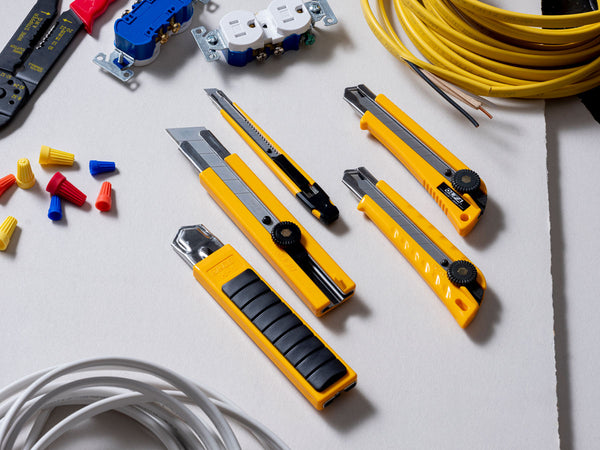
Tools for the Construction Site: Q&A with OLFA Experts
Working in the construction field is no easy feat, with often long hours, a busy jobsite, and one task after another. This makes durable tools a crucial part of the work, ensuring that workers can count on their equipment to get the job done.

We asked our OLFA All-Stars and Hall of Famers which knives they bring to any construction site. Everything from the PL-1, MXP-AL, H-1, XH-AL, LA-X, GSR-2, and XA-1 proved to be fan favorites, showing off their design for everyday use in any kind of job.
Desmond, Josh, Frankie, Sasha, John, and Ryan share their expert insights on what makes a knife useful for any construction task:
What do you find to be the most useful features of OLFA knives when it comes to construction jobs?
Desmond: I like that they store extra blades, they’re lightweight, and they’re the perfect size. I’ve used the same knife for over 18 years.
Josh: My favorite feature is the grip and comfort of the MXP. I also prefer the ratchet design with the snap-off blade, instead of changing blades into a utility knife.
Frankie: The fact it can do multiple things, plus the back metal pry piece.
Sasha: They’ve got great grip and are heavy duty, which makes them good for most jobs on site.
John: Size! I love how compact my XA-1 is; it fits perfectly in my shirt pocket or painter pants. When you’re constantly moving, climbing ladders, or on a roof, you want a compact yet effective tool.
Ryan: My favorite feature is the retractable blades and how easy they change out. Also, the snap-off ability is amazing!
What are the most common tasks you perform on a construction site that require the use of a knife? What specific materials do you frequently need to cut?
Desmond: Tyvek, tar paper, scoring vinyl siding, and cutting tape are common for me.
Josh: I use knives as an electrician quite often. Opening boxes and packaging, plus cutting cardboard and paper is common. I also cut drywall, plaster, wire insulation, wire jackets, stickers and labels, and more.
Frankie: I often cut plastic, tape, underlayment, and opening paint cans.
Sasha: Lumber straps, Tyvek, insulated, poly, and much more are cut with my OLFA knife.
John: We cut a lot of paper, plastic, and tape. We also use our knives to cut drywall and to score baseboards or door trim prior to removal. Using the knife to cut the caulking that connects the trim to the walls is also helpful when trying to keep walls from being damaged.
Ryan: I cut lumber banding (fabric) and house wrap. Drywall, siding, and roofing are also in the mix.

Are there any safety concerns or preferences you have when it comes to using a knife on a construction site?
Desmond: I prefer the thumb lock (dial) to keep the blade locked, so it doesn’t suddenly retract if I’m putting a lot of pressure on it, and to store the knife in a hard sheath.
Josh: Safety concerns when using a knife are serious. The most common is cuts, and to prevent cuts I use PPE such as gloves and glasses. The other concern is slipping with dull knives, but the quality of OLFA snap-off blades help with that.
John: Yes! OLFA knives are perfect when having to cut drywall around areas where wiring or electrical is exposed. The plastic handles help reduce the risk of electrocuting yourself, because the handle won’t conduct electricity.
Do you require a knife that can handle heavy-duty cutting or precision work, or both?
Sasha, Desmond, and John: Both.
Josh: I think it depends on the job. Precision would be needed when stripping cables, and heavy-duty knives are essential for commercial jobs.
Frankie: Definitely both, but specifically for me I need precision for detail tapping and more intricate tasks.
Ryan: Yes, yes, and yes. Personally, I use heavy duty for daily use, but precision is the ideal knife for jobs that involve ceiling tiles, as well as carpet.
How important is durability and longevity in a construction knife for you?
Desmond: Durability is number one. I’ve tried many brand knives that store extra blades and they always seemed to fail. I’ve used the PL-1 for 18 years and it still works as intended
Josh: Durability and longevity are important. I don't want a knife failing or breaking while in use and I don’t want to keep spending money replacing tools.
Frankie: Very. I need a knife I can depend on. The more durability it has, the less knives I need to have on me.
Sasha: Very important — from saving time, money, to helping the environment — durability and longevity is key.
John: Extremely important! The body of OLFA knives are extremely tough and durable. Then, there’s the blades — when you’re 20 feet up a ladder or on a hot roof, you want to get in and get out of there quickly. If my blade is dull, I know I can easily snap off the old one, and instantly have a sharp knife.
Ryan: Very important. Too many things are disposable these days.

Do you prefer a retractable blade, fixed blade, or snap-off blade design for your construction tasks?
Desmond: Snap-off for a sharp point whenever necessary.
Josh: I like both. I prefer a retractable blade to keep the blade protected when storing it in my tool belt, and I prefer a snap-off blade so that I am keeping a sharp, safe edge instead of needing the change blades. The ratchet MXP is the best of both worlds.
Frankie: Depends on the task. But overall, I like snap-off and retractable.
Sasha: Snap-off.
John: OLFA snap-off blades are the only blades I use!
Ryan: Retractable with the snap-off blades are excellent.
Are there any specific features you find crucial in a construction knife, such as a comfortable grip, safety mechanisms, or blade-changing ease?
Desmond: Mainly that it does what is intended and there is no down time changing blades or fiddling with faulty mechanism. So, durability is key.
Josh: A critical feature in a construction knife is durability of the blade and blade holder. We can be hard on tools and when dealing with knives, safety is important. A strong body that will not break or crack is absolutely critical. Comfort is a bonus. They all need to work together to ensure safe and reliable use.
Frankie: Blade changing, ease, and comfort are crucial. On certain tasks, I have a blade in my hand the whole day and comfort is a must.
Sasha: Comfortable grip! When using the knife for a long time, the hand comfort is crucial.
John: Comfort and size of tools is critical if I’m using it for hours to cut plastic, tape or paper. Blade changing is a biggie when it comes to picking the right tool. I have found nothing better than OLFA when it comes to ease of use.
Ryan: Comfortable in the hand is most important for me.
Do you typically carry multiple types of knives to a job, or do you prefer a single multi-purpose knife?
Desmond: I prefer a single multipurpose knife as I like to keep my tool belt light.
Josh: I typically carry multiple knives. I use the MXP-AL most often and keep it in a knife sheath attached to my tool belt. However, I also carry a utility knife in my pocket as part of my EDC for opening boxes and random tasks. I also have a specific cable stripping knife in my tool belt; it is a small, fixed blade knife. As an electrician I sometimes will also carry a fixed hook blade knife for cable stripping. Lastly, I always have an extra knife or two on me or nearby to lend to fellow coworkers or tradespeople if required.
Frankie: Mutiple knifes for sure. But some knives make it so you don’t have to have so many others, due to having multi-purposes.
John: I carry two favorites for cutting materials, such as paper, plastic, cardboard and tape: XA-1 and my L-2. For scraping paint off windows, I use my GSR-2.
Ryan: I usually only have one knife in my tool belt at a time. But the others are always close by in the truck toolbox in case a different need arises!

In the demanding world of construction, reliability, and durability are essential. Guarantee efficiency with the right equipment. Check out which OLFA tools will help you complete your next job with ease.


